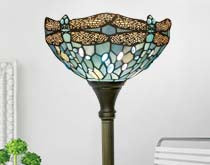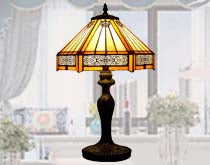Why Do LED Lights Flicker? What Do You Know?
LED lights are becoming more and more popular in daily life. Whether it is an elegant Tiffany table lamp or a floor lamp in the corner of the living room, LED bulbs have become the mainstream of the lighting market with their energy-saving, high-efficiency, and long life. However, many users will encounter the problem of LED light flickering during use, which not only affects the lighting effect, but may also cause discomfort and safety hazards.
Understanding the reasons for LED light flickering can help us better solve this problem and ensure the stability and comfort of the light. This article will explore the common reasons for LED light flickering and provide corresponding solutions.
Why do LED Lights Flicker?

There are many reasons why LED lights flicker, and understanding them can help you better prevent this problem, whether you have modern LED bulbs or classic Tiffany lamps.
Improper Wiring
Improper wiring can also cause LED lights to flicker. Incorrect wiring interferes with the electrical flow. This interference can cause erratic light output. Always follow the manufacturer's wiring guidelines for LED fixtures when wiring.
Hiring a professional electrician can ensure proper installation. Proper wiring reduces the risk of flicker and extends the life of your LED lights. Regularly checking your wiring can help maintain optimal performance.
Voltage Fluctuations
Voltage fluctuations can cause LED lights to flicker. Even small changes in voltage can affect light output. This is because LEDs are sensitive to electrical changes. The power supply can be unstable. This instability can cause lights to flicker.
A study found that voltage fluctuations can cause severe flickering. This problem often occurs in areas with unstable power grids. You may notice flickering during peak usage times. High-quality LED bulbs can handle these fluctuations better. Investing in quality bulbs can reduce flickering.
Incompatible Dimmers
Incompatible dimmers can also cause LED lights to flicker. Older dimmers were designed for incandescent bulbs. These dimmers don't work well with LEDs. The mismatch can cause the light to flicker.
LEDs require a specific type of dimmer. These dimmers provide a steady current. Using the right dimmer can prevent flickering. Be sure to check the compatibility of the dimmer with your LED bulb. Manufacturers usually provide this information on the packaging.
LED Driver Issues
Poor quality drivers can cause LED lights to flicker. Drivers convert AC power to DC power. Poor quality drivers may not perform this conversion efficiently. This inefficiency can cause lights to flicker.
High-quality drivers ensure a steady current. This stability prevents flickering. Investing in a quality driver can save you from having to replace it frequently. Be sure to choose an LED light with a reliable driver.
Overheating Issues
Overheating can also cause LED lights to flicker. Overheating can affect the components inside the LED. This can cause flickering or even permanent damage. Proper ventilation can help control heat. Avoid placing LED lights in enclosed fixtures. This allows the heat to dissipate. Regular maintenance can also prevent overheating. Clean fixtures to ensure proper airflow.
Environmental Factors
Low temperatures can cause LED lights to flicker. LEDs rely on specific operating conditions. Cold temperatures can affect the electronics within the light. This disturbance can cause flickering. High humidity can also cause LED lights to flicker.
Moisture can seep into the LED components. Moisture can cause short circuits. Short circuits can disrupt the flow of electricity, causing flickering.
How to Prevent Lights from Flickering

To effectively prevent your lights from flickering, you can take the following measures:
Use a compatible dimmer switch: Make sure to choose a dimmer switch that is compatible with your LED lights to avoid current fluctuations and keep the lights stable.
Ensure a secure connection: Regularly check the connection between the lamp and the power supply to ensure that all connection points are secure and reliable to prevent current interruptions caused by loose connections.
Stabilize the power supply voltage: Use a stable power supply voltage, or install a voltage regulator to prevent power supply voltage fluctuations from affecting the LED lights and keep the lights stable.
Choose high-quality LED bulbs: Choose LED bulbs with guaranteed quality and avoid using inferior products. This ensures that the internal circuit design and component quality meet the standards and reduce the possibility of flickering.
Improve heat dissipation conditions: Ensure that the LED lamp has good heat dissipation conditions to avoid overheating problems. You can reduce the temperature of the lamp by using a heat sink or improving ventilation to prevent flickering.
Use a reliable LED driver: Choose a reliable quality LED driver to ensure that it can provide a stable current supply. The driver is an important component for the normal operation of the LED lamp. A stable driver can effectively prevent flickering.
The above measures to avoid LED light flicker can effectively reduce or eliminate the flicker problem of LED lights and improve the lighting quality and visual comfort of your space.
Summary
LED light flicker is a common but annoying problem. Understand these reasons. By correctly selecting compatible dimmer switches, ensuring that the power connection is firm, using stable power supply voltage, selecting high-quality LED bulbs, improving heat dissipation conditions, and using reliable LED drivers, we can effectively prevent and solve the problem of LED light flicker.
Mastering this knowledge can not only improve the lighting quality but also extend the service life of LED lights, bringing a more comfortable and safe lighting experience.
If you want to buy suitable lighting fixtures, you can browse the Tiffany lamp on the werfactory website. These lamps have their own characteristics, and you can choose the right style according to your house space.
FAQ
Can flickering LED lights cause damage to the eyes?
Yes, flickering LED lights can cause damage to the eyes. Prolonged exposure to flickering lights can cause eye fatigue, discomfort, and even vision problems.
To protect eye health, it is important to promptly address LED light flicker issues, including using high-quality bulbs, ensuring a stable power supply, and dimmer switch compatibility.
Do LED bulbs flicker before they burn out?
Yes, LED bulbs can flicker before they burn out, often due to power supply issues, internal component aging, or driver failures, indicating that the bulb may need to be replaced soon.
Related reading: How can I tell if a Tiffany style lamp is plastic or glass?



























